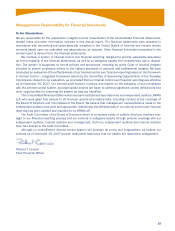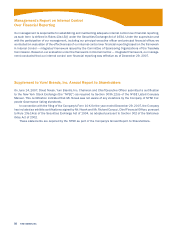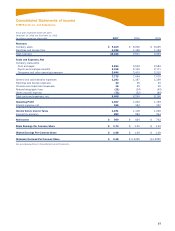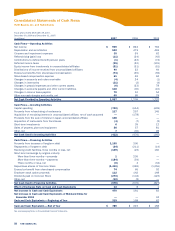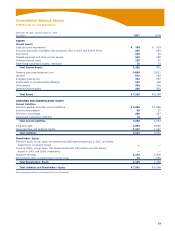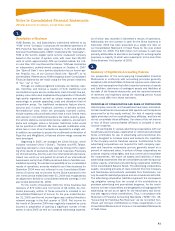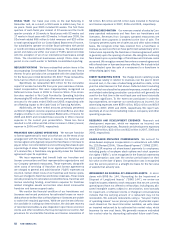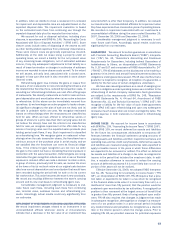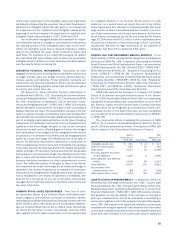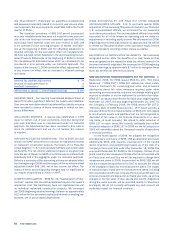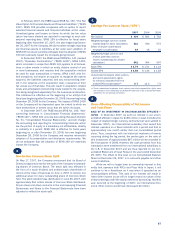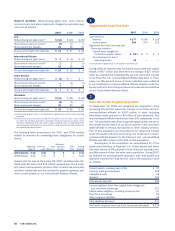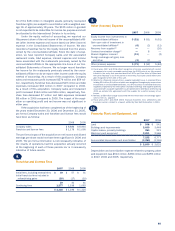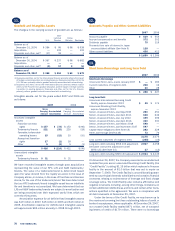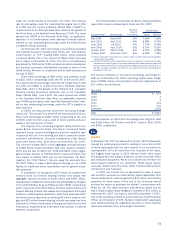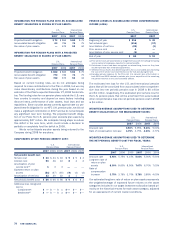Pizza Hut 2007 Annual Report Download - page 61
Download and view the complete annual report
Please find page 61 of the 2007 Pizza Hut annual report below. You can navigate through the pages in the report by either clicking on the pages listed below, or by using the keyword search tool below to find specific information within the annual report.
65
willing buyer would pay for the intangible asset and is generally
estimated by discounting the expected future cash flows associ-
ated with the intangible asset. We also perform our annual test
for impairment of our indefinite-lived intangible assets at the
beginning of our fourth quarter. No impairment of indefinite-lived
intangible assets was recorded in 2007, 2006 and 2005.
Our amortizable intangible assets are evaluated for impair-
ment whenever events or changes in circumstances indicate that
the carrying amount of the intangible asset may not be recov-
erable. An intangible asset that is deemed impaired is written
down to its estimated fair value, which is based on discounted
cash flows. For purposes of our impairment analysis, we update
the cash flows that were initially used to value the amortizable
intangible asset to reflect our current estimates and assumptions
over the asset’s future remaining life.
DERIVATIVE FINANCIAL INSTRUMENTS Historically we have
engaged in transactions involving various derivative instruments
to hedge interest rates and foreign currency denominated pur-
chases, assets and liabilities. These derivative contracts are
entered into with financial institutions. We do not use derivative
instruments for trading purposes and we have procedures in place
to monitor and control their use.
We account for these derivative financial instruments in
accordance with SFAS No. 133, “Accounting for Derivative Instru-
ments and Hedging Activities” (“SFAS 133”) as amended by SFAS
No. 149, “Amendment of Statement 133 on Derivative Instru-
ments and Hedging Activities” (“SFAS 149”). SFAS 133 requires
that all derivative instruments be recorded on the Consolidated
Balance Sheet at fair value. The accounting for changes in the fair
value (i.e.,gains or losses) of a derivative instrument is dependent
upon whether the derivative has been designated and qualifies as
part of a hedging relationship and further, on the type of hedging
relationship. For derivative instruments that are designated and
qualify as a fair value hedge, the gain or loss on the derivative
instrument as well as the offsetting gain or loss on the hedged
item attributable to the hedged risk are recognized in the results
of operations. For derivative instruments that are designated and
qualify as a cash flow hedge, the effective portion of the gain or
loss on the derivative instrument is reported as a component of
other comprehensive income (loss) and reclassified into earnings
in the same period or periods during which the hedged transaction
affects earnings. For derivative instruments that are designated
and qualify as a net investment hedge, the effective portion of the
gain or loss on the derivative instrument is reported in the foreign
currency translation component of other comprehensive income
(loss). Any ineffective portion of the gain or loss on the deriva-
tive instrument for a cash flow hedge or net investment hedge is
recorded in the results of operations immediately. For derivative
instruments not designated as hedging instruments, the gain or
loss is recognized in the results of operations immediately. See
Note 15 for a discussion of our use of derivative instruments,
management of credit risk inherent in derivative instruments and
fair value information.
COMMON STOCK SHARE REPURCHASES From time to time,
we repurchase shares of our Common Stock under share repur-
chase programs authorized by our Board of Directors. Shares
repurchased constitute authorized, but unissued shares under the
North Carolina laws under which we are incorporated. Addition-
ally, our Common Stock has no par or stated value. Accordingly,
we record the full value of share repurchases, upon the trade
date, against Common Stock except when to do so would result
in a negative balance in our Common Stock account. In such
instances, on a period basis, we record the cost of any further
share repurchases as a reduction in retained earnings. Due to the
large number of share repurchases and the increase in our Com-
mon Stock market value over the past several years, our Common
Stock balance is frequently zero at the end of any period. Accord-
ingly, $1,154 million and $713 million in share repurchases were
recorded as a reduction in retained earnings in 2007 and 2006,
respectively. We have no legal restrictions on the payment of
dividends. See Note 19 for additional information.
PENSION AND POST-RETIREMENT MEDICAL BENEFITS In the
fourth quarter of 2006,we adopted the recognition and disclosure
provisions of SFAS No. 158, “Employers’ Accounting for Defined
Benefit Pension and Other Postretirement Plans—an amendment
of FASB Statements No. 87, 88, 106 and 132(R)” (“SFAS 158”).
SFAS 158 amends SFAS No. 87, “Employers’ Accounting for Pen-
sions” (“SFAS 87”), SFAS No. 88, “Employers’ Accounting for
Settlements and Curtailments of Defined Benefit Plans and for
Termination Benefits” (“SFAS 88”), SFAS No. 106, “Employers’
Accounting for Postretirement Benefits Other Than Pensions”
(“SFAS 106”) and SFAS No. 132(R), “Employers’ Disclosures
about Pensions and Other Postretirement Benefits.”
SFAS 158 required the Company to recognize the funded
status of its pension and post-retirement plans in the Decem-
ber 30, 2006 Consolidated Balance Sheet, with a corresponding
adjustment to accumulated other comprehensive income, net of
tax. Gains or losses and prior service costs or credits that arise
in future years will be recognized as a component of other com-
prehensive income to the extent they have not been recognized
as a component of net periodic benefit cost pursuant to SFAS 87
or SFAS 106.
The incremental effects of adopting the provisions of SFAS
158 on the Company’s Consolidated Balance Sheet at Decem-
ber 30,2006 are presented as follows. The adoption of SFAS 158
had no impact on the Consolidated Statement of Income.
Before After
Application of Application of
SFAS 158 Adjustments SFAS 158
Intangible assets, net $ 350 $ (3) $ 347
Deferred income taxes 283 37 320
Total assets 6,334 34 6,368
Accounts payable and other
current liabilities 1,384 2 1,386
Other liabilities and deferred
credits 1,048 99 1,147
Total liabilities 4,815 101 4,916
Accumulated other
comprehensive loss (89) (67) (156)
Total shareholders’ equity 1,519 (67) 1,452
QUANTIFICATION OF MISSTATEMENTS In September 2006, the
Securities and Exchange Commission (the “SEC”) issued Staff
Accounting Bulletin No. 108, “Considering the Effects of Prior Year
Misstatements when Quantifying Misstatements in Current Year
Financial Statements” (“SAB 108”). SAB 108 provides interpre-
tive guidance on how the effects of the carryover or reversal of
prior year misstatements should be considered in quantifying a
current year misstatement for the purpose of a materiality assess-
ment. SAB 108 requires that registrants quantify a current year
misstatement using an approach that considers both the impact
of prior year misstatements that remain on the balance sheet and
those that were recorded in the current year income statement


